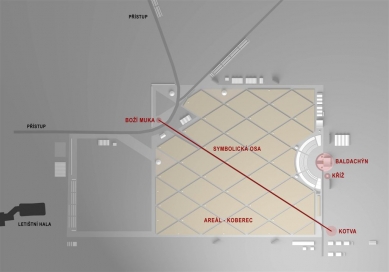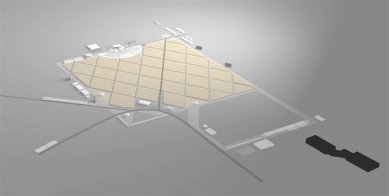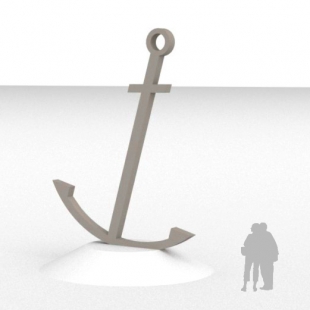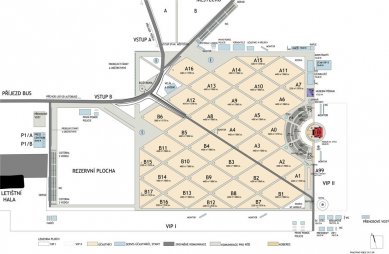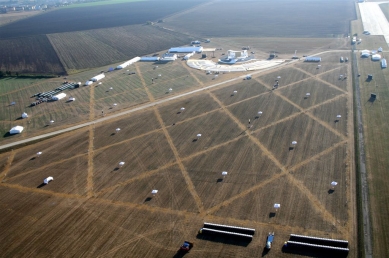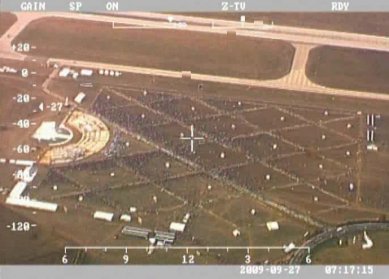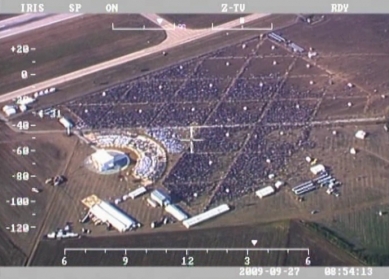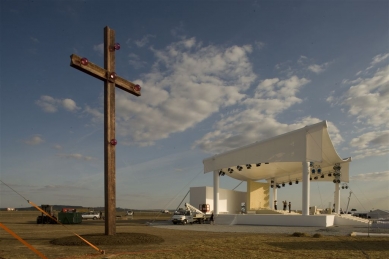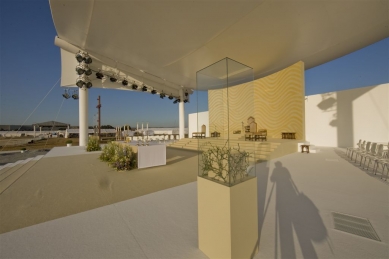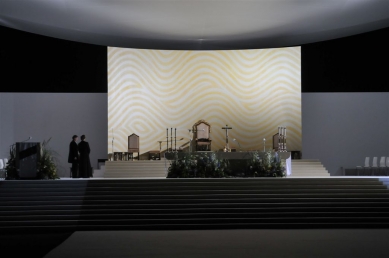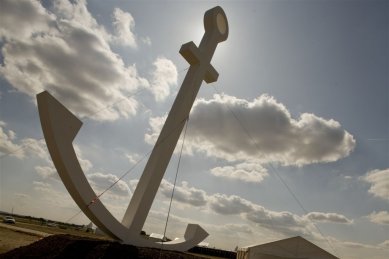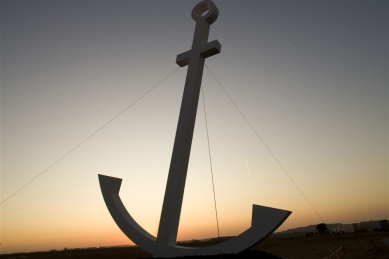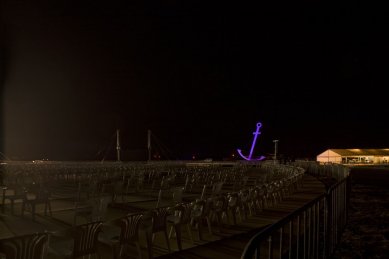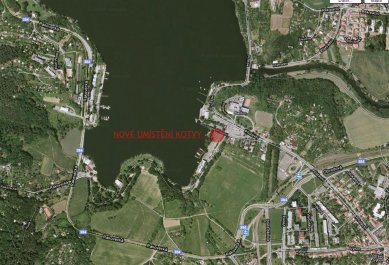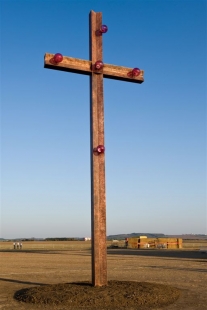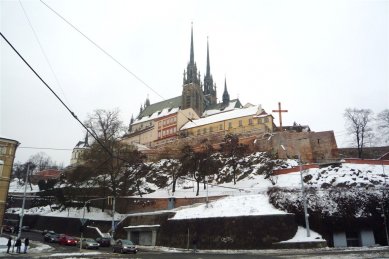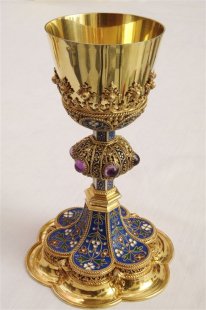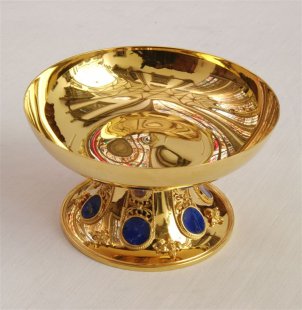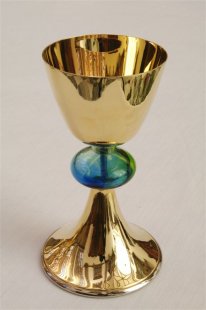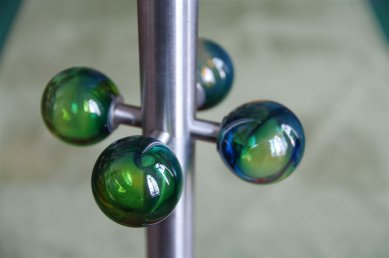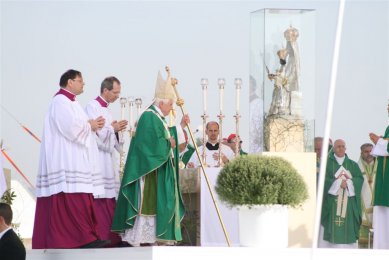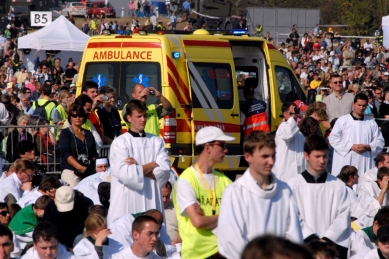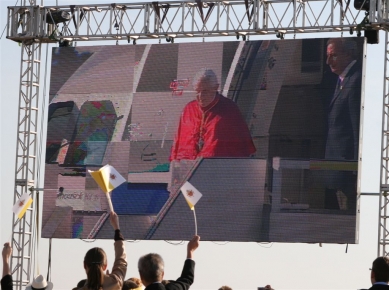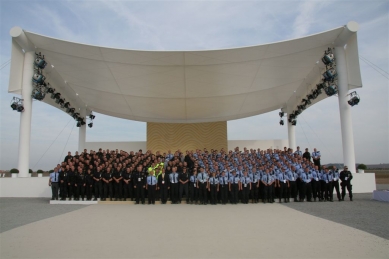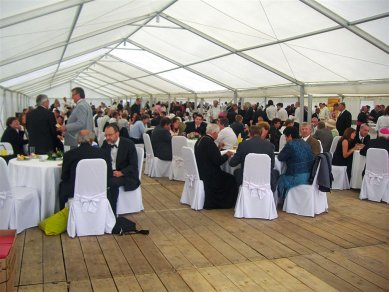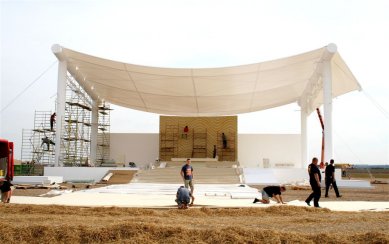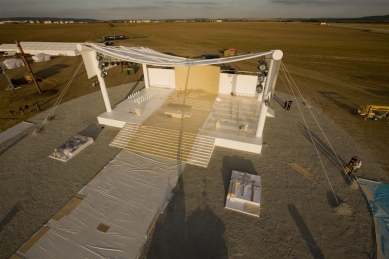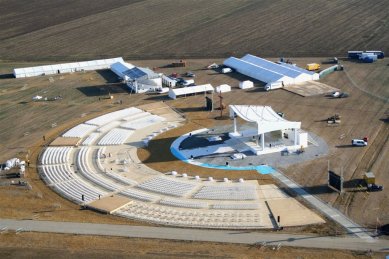
The area of the Mass of Benedict XVI in Brno

Pope Benedict XVI arrived in Brno on a government plane at 9:22 AM and departed at 12:46 PM, spending a total of 204 minutes in Brno. His visit was the first historic visit of the head of the Catholic Church to the Brno Diocese. Pope Benedict XVI came to the Czech Republic at the invitation of the Czech Bishops' Conference and the Office of the President of the Republic. The organization of the Brno Mass was entrusted to the Diocese of Brno. A large number of people worked on the preparations for the visit. Their exact number is hard to determine; according to my surveys, hundreds were involved in the actual preparations and about two thousand people in the organization itself. A partial idea can be gleaned from the list of various organizations and entities that prepared for the visit – Diocese of Brno, Office of the President of the Republic, Statutory City of Brno, South Moravian Region, Brno Airport a.s., Unit for the Protection of Constitutional Officials, Transport Department of the Regional Police Directorate of JMK, Foreign Police, Brno City Police, Ministry of Transport of the Czech Republic, Brno Public Transport Company, Czech Railways, Integrated Transport System JMK, Kordis Company, Brno Communications a.s., Health Council of JMK, Emergency Medical Services, Maltese Aid, Czech Red Cross, Diocesan Charity Brno, Regional Hygiene Station, Army of the Czech Republic, Military Police, Field Hospital, Olomouc Garrison Band, South Moravian Fire Rescue Service, volunteer fire brigades, the town of Šlapanice, Šlapanice City Police, Orel, Czech Television, Czech Press Agency, Sako Brno a.s., Atelier Štěpán s.r.o., Sun Drive s.r.o., Bonagro s.r.o., Archtex/Kontis, Kovářství Janda, Johnny Servis s.r.o., Signex spol. s.r.o.
About the concept
The basic concept of the area was developed relatively quickly due to the available time. An enormous carpet is spread across the field in front of Brno Airport. Just like in a room, here it occupies a piece of space, only on a different scale – in the scale of the local landscape. This precisely defined rectangle, measuring just under half a kilometer, is interwoven with a network of diagonal paths that form its decoration. From the view of the airplane, the area of the Mass appears as a large carpet with a diagonal pattern. This arrangement has several reasons, such as the location of an existing path that was incorporated into the fabric of the paths. Another is the orientation to the cardinal directions – participants will be facing east and so on. The entire area is almost perfectly oriented towards the cardinal directions. A special and symbolic role in entering the area is played by the old wayside shrine in the bend of the road in the northwestern corner of the area. It indicates the small contribution of each individual on the path of faith through time. The person who built it surely did not anticipate what event would take place here in the future. This old structure marks the beginning of the main symbolic axis of the area. At the opposite end of the axis is a ten-meter anchor - a symbol of hope and, at the same time, of the papal visit to Brno. This axis of the wayside shrine - anchor expresses the connection between generations. The papal podium is located at the main focal point of the area. The podium is pure white, covered with a canopy, and is oriented to the west. Next to the podium stands a large bronze cross.
About the area
During the construction of the area, which lasted exactly 26 days, a large carpet decoration appeared in the field in front of the airport. The area of this carpet - a seating area for pilgrims amounting to 25 football fields - was divided into two sections A and B, which were further divided into individual rhombus-shaped sectors with a capacity of approximately 6,000 people each. Each of the 25 sectors was equipped with its own information booth. Sector A5 was specifically designated for families with small children. The space for priests, VIPs, and handicapped visitors was located immediately near the main podium and was shaped like a circular segment, equipped with white chairs. The walkway surface of this area was reinforced. At both ends of the semicircle were spaces for the press. The area was divided into a secured and unsecured zone; the secured zone was naturally separated by the airport fence and was extended towards the papal podium. The capacity of the area was designed for 120,000 to 150,000 people. On the edges of the area, the necessary facilities in the form of large white tents, first aid stations, and portable toilets were set up. Tents for the pope, VIPs, and bishops were situated on the concrete surface and had separate catering and toilets. Additionally, within the area were tents for organizers (10x5m, 6x3m), participants in traditional costumes (10x5m), a chapel (15x10m), priests (60x10m), assistance (15x10m), performers (30x10m), and catering (40x25m). The precise distribution of the respective tents can be seen from the layout. At the bend of European Street, a dispatch tent was placed from which the area would be monitored by police, firefighters, medical personnel, and the organizer. The area included appropriately located toilets in sufficient numbers, waste containers, and refreshment stalls. The area was equipped with sound with 6 sound towers; the sound engineer's station was near the VIP zone. Additionally, there were 6 large LED screens for transmitting images to more distant areas. The space was equipped with 12 television cameras.
About the canopy
The podium stood on a marked circle that indicated the exceptional nature of the location within the area. The podium was oriented to the west and was divided into three height levels and accessed by four stairways. It measured 26x22m and had a height of 12m. On the podium stood the pope, his concelebrants, and 40 bishops. There was liturgical furniture in a cream color. At the front was a statue of Our Lady of Tuřany, the oldest statue of its kind in Brno. When looking from his sede at the statue of Our Lady, Benedict XVI had the Tuřany church directly behind it, from where the statue originates. The rear arched wall was treated by Petr Kvíčala with the theme of vast waters before which the pope docked. The canopy, with a gentle curve covering the podium at a height of twelve meters, was pure white. The canopy, as a millennia-old archetype of roofing, was intentionally selected for its conservative and clear shape resembling a heavenly vault. It has been used throughout Europe and beyond. It is a symbolic reference to the tent dwelling or tabernacle, which plays an important role in biblical history and is mentioned countless times in the Bible itself. However, the canopy at the airport was of a very simple form and modern design. The structure of the canopy was technically unique. It consisted of a pre-tensioned membrane on a steel spatial structure with an extremely low thickness. This thickness was unnoticeable from the viewers' perspective. The membrane was welded into a single piece of impressive dimensions 25x17 m and was pre-tensioned on the shorter sides with stainless steel cables. The seams of the membrane were diagonal in accordance with the angle of the individual sectors of the area. The total weight of the entire roofing was 9.5 tons, of which the membrane weighed 450 kg, its strength being approximately 6 tons per meter in width. The shape of the membrane and the static calculation were created using special software such that it would withstand the pressure of a 100 km/h wind. The supportive structure of the membrane consisted of four steel columns and sloped beams with overhanging ends. They were of triangular truss design, covered with circular cardboard cladding. The stabilization of the entire system was ensured by anchoring cables with rectification. These were anchored into the ground with driven piles of approximately 3 m depth. These piles were removable and were pulled out after the event. The bases under the columns were on a distributing steel plate. The total amount of iron used, including the foundations, was 17 tons.
About the anchor
The anchor was positioned on the imaginary spiritual axis of the area, which leads from the old wayside shrine to this anchor. It is a symbol of hope, and hope was the guiding theme of Benedict XVI's visit to the Brno Diocese. This axis connects the past - our ancestors who built the wayside shrines, through the present - a shared worship - to the future - with hope. Benedikt XVI arrived along this axis in his papamobile. The anchor is 11 m tall and was placed on a meter-high mound. It is slightly stylized and white in color, just like most of the area. The anchor was to be recycled, but due to its great popularity, it will be newly placed at Brno Reservoir. It has a light construction made of fine truss covered with sealed plywood. The stabilizing base below it was hidden in the mound. Stage lighting was used to illuminate it. The anchor was erected on September 23, 2009, at 1:20 PM. Its re-erection at the Brno Reservoir wharf area is expected in June 2010.
About the cross
The architectural and artistic style of the cross – a symbol of Christianity is abstract. Both of its arms have an inward break in the shape of an X. The cross is without a corpus, supplemented with blown glass at the nail points. These symbolize the five wounds of Christ. The blown glass spheres have a symbolic and rare red color, achieved by adding gold to the glass. It is created using contemporary technology with a closed thin-walled stainless structure fully clad in bronze. Thus, it technically and economically effectively utilizes the best properties of both materials. The internal structure made of stainless steel is 3-5 mm thick, fulfilling a technical and load-bearing function, while the bronze serves an aesthetic function that remains constant over time. The construction is very light due to the properties mentioned. The cross stands 12 m tall and weighs only just under one ton. The prototype of the construction was developed for use in the environment of National Cultural Monuments. The cross was manufactured at the workshop of Martin Janda in Osík near Litomyšl. The glass spheres are the work of glassmakers from Nové Bor. The cross was transported as oversized cargo to Brno on Wednesday, September 23. Loading at the workshop happened on Wednesday at 9 AM, and it was erected the same day within a few minutes in the afternoon. The spheres were placed on September 24 in the afternoon. The cross, which stood next to the papal podium, is an artifact that will permanently remind visitors of the historic first visit of the pope to Brno. Subsequently, it will be placed in the center of Brno, near St. Peter and Paul Cathedral, not far from the upper terrace of the Capuchin gardens. In this context, the artifact will have a location that will create a visible Golgotha from afar from the south on the triangular terrace, while it will also be perceptible from the upper Capuchin terrace, where intimate Gethsemanes will arise. This place is also touristically attractive and easily accessible.
About the liturgical items
During the Mass, Benedict XVI and his concelebrants used a gold-blue liturgical set at the altar. The chalice was specifically selected by the pope's secretary, P. Marini, from those presented. The golden chalice from the 19th century is decorated with filigree and blue enamel. A bowl and four chalices for the concelebrants were newly made for this unique chalice. The bowl follows the shape and technology of chalice manufacturing. The chalices for the concelebrants were supplemented with a walnut from blue-green blown glass. At the altar, there stood a golden cross with a white corpus of Jesus facing the pope. This old cross was newly restored for this occasion. On either side of the cross and behind it stood seven twisted candlesticks from the cathedral. On special tables in front of the podium, there were another 400 ceramic offering bowls, specially manufactured for this occasion.
Six lightweight stainless steel candlesticks were specially made for the deacons for the Mass. They have a slender, tall shape decorated with four glass spheres. The green-blue spheres are arranged in the configuration of a cross at the top of the candlestick. The color of the glass spheres was chosen according to the liturgical color - green - and according to the blue color of the chalice that Benedict XVI will have during the Mass. The candlesticks were designed according to the design of the area architect for an inserted oil candle made of stainless steel and are 90 cm tall. They were used, for example, in the liturgical procession or during the reading of the gospel.
About transportation
Access roads to the area led from the north and west via local paved roads. Large information centers were located along these routes. The movement of people to the area was coordinated by police officers and organizers with the help of soldiers. According to the city police, a total of 4,150 personal cars and 852 buses arrived for the Mass, of which only six did not park on the D1 motorway. The D1 motorway was closed from kilometers 196 to 203 from Saturday at 6 PM until 5:02 PM on Sunday afternoon, when it was made passable two hours before the expected reopening. Around 1:30 PM, the convoy on the motorway temporarily stopped. A huge wave of pilgrims was heading from the motorway parking lot to the area. The Brno Public Transport Company transported the pilgrims with special buses providing free shuttle service from the center and from the personal car parking lot at one-minute intervals. Stops near the area were visibly marked. Czech Railways dispatched nine special trains that stopped at the Slatina and Šlapanice stations. In addition, all regular regional routes that stop at the main station were strengthened. The pilgrims were patient, and no unexpected complications arose. The entire situation was monitored by a police helicopter.
About the Mass
The Mass on September 27, 2009, in Brno lasted 127 minutes. The liturgical color was green, therefore, Benedict XVI, the concelebrants, and the bishops wore green vestments; this color was also indicated on the ambo, from which the Gospel was read.
During the service with the pope, forty bishops and a thousand priests concelebrated, more than two hundred of whom were from abroad. At the end of the service, Benedict XVI offered his apostolic blessing to all the participants. This blessing also includes the blessing of the cornerstones of sacred buildings and other liturgical items (rosaries, medals, pictures). The pilgrims at the Mass came from all parts of Moravia, as well as from Bohemia, Slovakia, Poland, Austria, Germany, and Hungary. In smaller groups, there were also pilgrims from Europe and around the world. The most distant known pilgrims were two people from Chile. There were about 11,000 foreign visitors at the Mass, most of whom were from Slovakia. Within the designated space for VIP participants, prominent politicians attended the Mass, including Czech Republic President Václav Klaus with his wife, Brno Mayor Roman Onderka, and South Moravian Region Governor Michal Hašek. The organizing service numbered over 1,000 people in 30 groups in the sectors. They were assisted by 200 soldiers who ensured good accessibility and passage of roads and 300 medical personnel. In each of the 25 sectors, there was at least one doctor and six to twelve other medical staff. At four locations, there were stations of the Emergency Medical Services, a total of ten crews with top-equipped ambulances, as well as two backup crews and two vehicles. Near the airport terminal was a field hospital and air rescue services with a modern helicopter.
photograph authors: Vít Kobza, Zdeněk Kolařík, Tino Kratochvíl, Ota Nepilý, Petr Pilát, Marie Šmerková, Marie Zezůlková, archive of Atelier Štěpán, archive of the Diocese of Brno, archive of the Statutory City of Brno, archive of the South Moravian Region, archive of the Czech Police, archive of Johnny Servis, archive of Atelier Hrůša, archive of Brno Airport
About the concept
The basic concept of the area was developed relatively quickly due to the available time. An enormous carpet is spread across the field in front of Brno Airport. Just like in a room, here it occupies a piece of space, only on a different scale – in the scale of the local landscape. This precisely defined rectangle, measuring just under half a kilometer, is interwoven with a network of diagonal paths that form its decoration. From the view of the airplane, the area of the Mass appears as a large carpet with a diagonal pattern. This arrangement has several reasons, such as the location of an existing path that was incorporated into the fabric of the paths. Another is the orientation to the cardinal directions – participants will be facing east and so on. The entire area is almost perfectly oriented towards the cardinal directions. A special and symbolic role in entering the area is played by the old wayside shrine in the bend of the road in the northwestern corner of the area. It indicates the small contribution of each individual on the path of faith through time. The person who built it surely did not anticipate what event would take place here in the future. This old structure marks the beginning of the main symbolic axis of the area. At the opposite end of the axis is a ten-meter anchor - a symbol of hope and, at the same time, of the papal visit to Brno. This axis of the wayside shrine - anchor expresses the connection between generations. The papal podium is located at the main focal point of the area. The podium is pure white, covered with a canopy, and is oriented to the west. Next to the podium stands a large bronze cross.
About the area
During the construction of the area, which lasted exactly 26 days, a large carpet decoration appeared in the field in front of the airport. The area of this carpet - a seating area for pilgrims amounting to 25 football fields - was divided into two sections A and B, which were further divided into individual rhombus-shaped sectors with a capacity of approximately 6,000 people each. Each of the 25 sectors was equipped with its own information booth. Sector A5 was specifically designated for families with small children. The space for priests, VIPs, and handicapped visitors was located immediately near the main podium and was shaped like a circular segment, equipped with white chairs. The walkway surface of this area was reinforced. At both ends of the semicircle were spaces for the press. The area was divided into a secured and unsecured zone; the secured zone was naturally separated by the airport fence and was extended towards the papal podium. The capacity of the area was designed for 120,000 to 150,000 people. On the edges of the area, the necessary facilities in the form of large white tents, first aid stations, and portable toilets were set up. Tents for the pope, VIPs, and bishops were situated on the concrete surface and had separate catering and toilets. Additionally, within the area were tents for organizers (10x5m, 6x3m), participants in traditional costumes (10x5m), a chapel (15x10m), priests (60x10m), assistance (15x10m), performers (30x10m), and catering (40x25m). The precise distribution of the respective tents can be seen from the layout. At the bend of European Street, a dispatch tent was placed from which the area would be monitored by police, firefighters, medical personnel, and the organizer. The area included appropriately located toilets in sufficient numbers, waste containers, and refreshment stalls. The area was equipped with sound with 6 sound towers; the sound engineer's station was near the VIP zone. Additionally, there were 6 large LED screens for transmitting images to more distant areas. The space was equipped with 12 television cameras.
About the canopy
The podium stood on a marked circle that indicated the exceptional nature of the location within the area. The podium was oriented to the west and was divided into three height levels and accessed by four stairways. It measured 26x22m and had a height of 12m. On the podium stood the pope, his concelebrants, and 40 bishops. There was liturgical furniture in a cream color. At the front was a statue of Our Lady of Tuřany, the oldest statue of its kind in Brno. When looking from his sede at the statue of Our Lady, Benedict XVI had the Tuřany church directly behind it, from where the statue originates. The rear arched wall was treated by Petr Kvíčala with the theme of vast waters before which the pope docked. The canopy, with a gentle curve covering the podium at a height of twelve meters, was pure white. The canopy, as a millennia-old archetype of roofing, was intentionally selected for its conservative and clear shape resembling a heavenly vault. It has been used throughout Europe and beyond. It is a symbolic reference to the tent dwelling or tabernacle, which plays an important role in biblical history and is mentioned countless times in the Bible itself. However, the canopy at the airport was of a very simple form and modern design. The structure of the canopy was technically unique. It consisted of a pre-tensioned membrane on a steel spatial structure with an extremely low thickness. This thickness was unnoticeable from the viewers' perspective. The membrane was welded into a single piece of impressive dimensions 25x17 m and was pre-tensioned on the shorter sides with stainless steel cables. The seams of the membrane were diagonal in accordance with the angle of the individual sectors of the area. The total weight of the entire roofing was 9.5 tons, of which the membrane weighed 450 kg, its strength being approximately 6 tons per meter in width. The shape of the membrane and the static calculation were created using special software such that it would withstand the pressure of a 100 km/h wind. The supportive structure of the membrane consisted of four steel columns and sloped beams with overhanging ends. They were of triangular truss design, covered with circular cardboard cladding. The stabilization of the entire system was ensured by anchoring cables with rectification. These were anchored into the ground with driven piles of approximately 3 m depth. These piles were removable and were pulled out after the event. The bases under the columns were on a distributing steel plate. The total amount of iron used, including the foundations, was 17 tons.
About the anchor
The anchor was positioned on the imaginary spiritual axis of the area, which leads from the old wayside shrine to this anchor. It is a symbol of hope, and hope was the guiding theme of Benedict XVI's visit to the Brno Diocese. This axis connects the past - our ancestors who built the wayside shrines, through the present - a shared worship - to the future - with hope. Benedikt XVI arrived along this axis in his papamobile. The anchor is 11 m tall and was placed on a meter-high mound. It is slightly stylized and white in color, just like most of the area. The anchor was to be recycled, but due to its great popularity, it will be newly placed at Brno Reservoir. It has a light construction made of fine truss covered with sealed plywood. The stabilizing base below it was hidden in the mound. Stage lighting was used to illuminate it. The anchor was erected on September 23, 2009, at 1:20 PM. Its re-erection at the Brno Reservoir wharf area is expected in June 2010.
About the cross
The architectural and artistic style of the cross – a symbol of Christianity is abstract. Both of its arms have an inward break in the shape of an X. The cross is without a corpus, supplemented with blown glass at the nail points. These symbolize the five wounds of Christ. The blown glass spheres have a symbolic and rare red color, achieved by adding gold to the glass. It is created using contemporary technology with a closed thin-walled stainless structure fully clad in bronze. Thus, it technically and economically effectively utilizes the best properties of both materials. The internal structure made of stainless steel is 3-5 mm thick, fulfilling a technical and load-bearing function, while the bronze serves an aesthetic function that remains constant over time. The construction is very light due to the properties mentioned. The cross stands 12 m tall and weighs only just under one ton. The prototype of the construction was developed for use in the environment of National Cultural Monuments. The cross was manufactured at the workshop of Martin Janda in Osík near Litomyšl. The glass spheres are the work of glassmakers from Nové Bor. The cross was transported as oversized cargo to Brno on Wednesday, September 23. Loading at the workshop happened on Wednesday at 9 AM, and it was erected the same day within a few minutes in the afternoon. The spheres were placed on September 24 in the afternoon. The cross, which stood next to the papal podium, is an artifact that will permanently remind visitors of the historic first visit of the pope to Brno. Subsequently, it will be placed in the center of Brno, near St. Peter and Paul Cathedral, not far from the upper terrace of the Capuchin gardens. In this context, the artifact will have a location that will create a visible Golgotha from afar from the south on the triangular terrace, while it will also be perceptible from the upper Capuchin terrace, where intimate Gethsemanes will arise. This place is also touristically attractive and easily accessible.
About the liturgical items
During the Mass, Benedict XVI and his concelebrants used a gold-blue liturgical set at the altar. The chalice was specifically selected by the pope's secretary, P. Marini, from those presented. The golden chalice from the 19th century is decorated with filigree and blue enamel. A bowl and four chalices for the concelebrants were newly made for this unique chalice. The bowl follows the shape and technology of chalice manufacturing. The chalices for the concelebrants were supplemented with a walnut from blue-green blown glass. At the altar, there stood a golden cross with a white corpus of Jesus facing the pope. This old cross was newly restored for this occasion. On either side of the cross and behind it stood seven twisted candlesticks from the cathedral. On special tables in front of the podium, there were another 400 ceramic offering bowls, specially manufactured for this occasion.
Six lightweight stainless steel candlesticks were specially made for the deacons for the Mass. They have a slender, tall shape decorated with four glass spheres. The green-blue spheres are arranged in the configuration of a cross at the top of the candlestick. The color of the glass spheres was chosen according to the liturgical color - green - and according to the blue color of the chalice that Benedict XVI will have during the Mass. The candlesticks were designed according to the design of the area architect for an inserted oil candle made of stainless steel and are 90 cm tall. They were used, for example, in the liturgical procession or during the reading of the gospel.
About transportation
Access roads to the area led from the north and west via local paved roads. Large information centers were located along these routes. The movement of people to the area was coordinated by police officers and organizers with the help of soldiers. According to the city police, a total of 4,150 personal cars and 852 buses arrived for the Mass, of which only six did not park on the D1 motorway. The D1 motorway was closed from kilometers 196 to 203 from Saturday at 6 PM until 5:02 PM on Sunday afternoon, when it was made passable two hours before the expected reopening. Around 1:30 PM, the convoy on the motorway temporarily stopped. A huge wave of pilgrims was heading from the motorway parking lot to the area. The Brno Public Transport Company transported the pilgrims with special buses providing free shuttle service from the center and from the personal car parking lot at one-minute intervals. Stops near the area were visibly marked. Czech Railways dispatched nine special trains that stopped at the Slatina and Šlapanice stations. In addition, all regular regional routes that stop at the main station were strengthened. The pilgrims were patient, and no unexpected complications arose. The entire situation was monitored by a police helicopter.
About the Mass
The Mass on September 27, 2009, in Brno lasted 127 minutes. The liturgical color was green, therefore, Benedict XVI, the concelebrants, and the bishops wore green vestments; this color was also indicated on the ambo, from which the Gospel was read.
During the service with the pope, forty bishops and a thousand priests concelebrated, more than two hundred of whom were from abroad. At the end of the service, Benedict XVI offered his apostolic blessing to all the participants. This blessing also includes the blessing of the cornerstones of sacred buildings and other liturgical items (rosaries, medals, pictures). The pilgrims at the Mass came from all parts of Moravia, as well as from Bohemia, Slovakia, Poland, Austria, Germany, and Hungary. In smaller groups, there were also pilgrims from Europe and around the world. The most distant known pilgrims were two people from Chile. There were about 11,000 foreign visitors at the Mass, most of whom were from Slovakia. Within the designated space for VIP participants, prominent politicians attended the Mass, including Czech Republic President Václav Klaus with his wife, Brno Mayor Roman Onderka, and South Moravian Region Governor Michal Hašek. The organizing service numbered over 1,000 people in 30 groups in the sectors. They were assisted by 200 soldiers who ensured good accessibility and passage of roads and 300 medical personnel. In each of the 25 sectors, there was at least one doctor and six to twelve other medical staff. At four locations, there were stations of the Emergency Medical Services, a total of ten crews with top-equipped ambulances, as well as two backup crews and two vehicles. Near the airport terminal was a field hospital and air rescue services with a modern helicopter.
photograph authors: Vít Kobza, Zdeněk Kolařík, Tino Kratochvíl, Ota Nepilý, Petr Pilát, Marie Šmerková, Marie Zezůlková, archive of Atelier Štěpán, archive of the Diocese of Brno, archive of the Statutory City of Brno, archive of the South Moravian Region, archive of the Czech Police, archive of Johnny Servis, archive of Atelier Hrůša, archive of Brno Airport
The English translation is powered by AI tool. Switch to Czech to view the original text source.
1 comment
add comment
Subject
Author
Date
Jsem rád!
Kaker
29.03.10 11:00
show all comments




